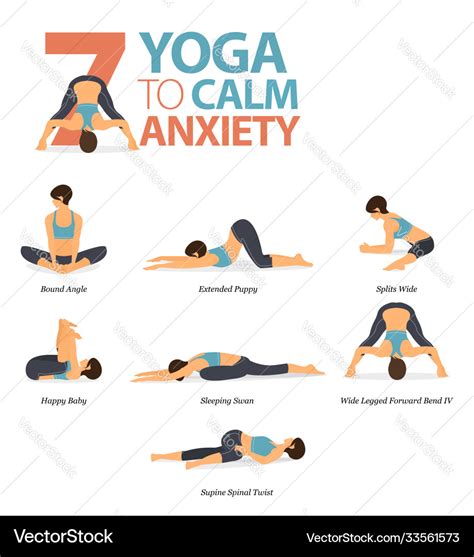Effective Yoga Techniques for Reducing Stress and Enhancing Calm
Stress is a prevalent issue in today’s fast-paced society, affecting individuals both mentally and physically. As a holistic approach to mental health and physical well-being, yoga offers powerful tools to counteract stress and cultivate calmness. In this article, we’ll explore specific yoga poses and techniques designed to alleviate stress, grounded in both traditional practices and modern research. Whether you’re a seasoned yogi or a beginner, these poses are accessible, effective, and supported by scientific evidence.
Key Concepts: Yoga and Stress Relief
Yoga is an ancient practice that combines physical postures (asanas), breathing techniques (pranayama), and meditation to promote mental clarity and emotional balance. Its benefits extend beyond mere flexibility and strength; it fosters relaxation and mental resilience. To understand how yoga can mitigate stress, we must focus on three essential concepts:
- Mind-Body Connection: Yoga integrates movement with breath, fostering a deep connection between the mind and body that helps to relieve tension.
- Activation of the Parasympathetic Nervous System: Deep breathing and slow, mindful movements encourage the parasympathetic response, often called the “rest and digest” system, which counters the stress-induced fight-or-flight response.
- Stress Hormone Reduction: Regular yoga practice has been shown to reduce levels of cortisol, the body’s primary stress hormone.
Historical Context: The Roots of Yoga for Mental Well-Being
While yoga is often viewed through the lens of physical fitness today, its origins are deeply rooted in spiritual and mental well-being. In ancient India, yoga was primarily practiced as a path toward self-realization and inner peace, with mental health being a key aspect of its philosophy. Texts like the Yoga Sutras of Patanjali, which date back over 2,000 years, emphasize the calming of the mind as a central goal. The practice of yoga for stress relief has therefore been an intrinsic part of its tradition since its inception.
Current State Analysis: Why Yoga Works for Stress Relief
In the modern context, yoga has gained recognition as a scientifically supported method for managing stress. Recent studies have demonstrated that yoga can reduce anxiety, depression, and perceived stress levels. Here’s why it works:
| Mechanism | Effect on Stress |
|---|---|
| Breathing Techniques (Pranayama) | Regulates heart rate, reduces blood pressure, and calms the nervous system. |
| Mindful Movement (Asanas) | Encourages the release of tension and helps the body recover from stress. |
| Mindfulness and Meditation | Fosters awareness, reducing overthinking and stress-inducing rumination. |
| Endorphin Release | Physical activity, including yoga, triggers the release of feel-good hormones like endorphins, enhancing mood and reducing stress. |
Practical Applications: Yoga Poses for Stress Relief
Here are five highly effective yoga poses known for their calming effects:
1. Child’s Pose (Balasana)
A gentle resting pose that helps alleviate anxiety, this pose encourages deep breathing, releasing tension from the back, shoulders, and neck.
2. Cat-Cow Pose (Marjaryasana-Bitilasana)
This flow between two postures improves spinal flexibility and encourages a calming focus on breath, which aids in stress reduction.
3. Legs-Up-the-Wall Pose (Viparita Karani)
This inversion pose allows the body to enter a deep state of relaxation. It helps reduce anxiety by relieving tension from the lower body and calming the nervous system.
4. Corpse Pose (Savasana)
Often used as the final resting pose in yoga practices, Savasana encourages total relaxation, promoting a deep sense of peace and stress release.
5. Bridge Pose (Setu Bandhasana)
By opening the chest and stretching the spine, this pose counteracts the effects of prolonged sitting and anxiety, encouraging a balanced mind and body.
Case Studies: Real-World Examples of Yoga for Stress
In recent years, studies and individual testimonials have highlighted yoga’s effectiveness in high-stress environments. For example:
- A 2018 study conducted on university students demonstrated a significant reduction in perceived stress levels after participating in a six-week yoga program.
- Incorporating yoga into corporate wellness programs has been shown to reduce burnout, absenteeism, and improve overall employee morale in several Fortune 500 companies.
- Yoga has also been successfully introduced in trauma-informed care programs for veterans, where it helps alleviate symptoms of PTSD and anxiety.
Stakeholder Analysis: Who Benefits from Yoga for Stress?
The practice of yoga for stress reduction is beneficial to a broad range of stakeholders, including:
- Employees: As workplace stress continues to rise, yoga offers a cost-effective solution to improve employee well-being.
- Healthcare Providers: Incorporating yoga into mental health treatments can complement traditional therapies, offering a holistic approach to stress management.
- Students: High academic pressure and performance anxiety make yoga a valuable tool for mental balance in educational settings.
- Individuals with Chronic Illnesses: Those managing long-term health conditions often experience elevated stress levels, which yoga can help mitigate.
Implementation Guidelines: How to Integrate Yoga into Your Daily Routine
Here are practical steps to start incorporating yoga for stress relief:
- Start with Breathing Exercises: Begin your practice with a simple pranayama technique like alternate nostril breathing to center yourself.
- Focus on Restorative Poses: Include at least one restorative pose, such as Child’s Pose or Legs-Up-the-Wall, in each session to calm the nervous system.
- Practice Regularly: Consistency is key. Aim for at least 15-20 minutes of yoga per day to notice substantial stress reduction.
- Incorporate Meditation: End each session with a few minutes of meditation or mindfulness to seal in the calm state.
Ethical Considerations in Promoting Yoga for Stress
While promoting yoga for stress relief is beneficial, there are important ethical considerations to address:
- Cultural Appropriation: Yoga’s deep cultural roots in India should be respected. Avoid commercializing the practice in ways that strip it of its heritage.
- Accessibility: Ensure that yoga is accessible to all, including individuals with physical limitations or disabilities. Modifications and inclusivity should be prioritized.
- Mental Health Sensitivity: While yoga can support mental health, it should not replace professional treatment for individuals with severe conditions. Encouraging a balanced approach between yoga and clinical care is essential.
Limitations and Future Research
While yoga has been widely recognized for its stress-relieving benefits, there are still limitations to consider:
- Limited Long-Term Studies: While short-term benefits of yoga for stress relief are well-documented, more long-term research is needed to understand its sustained impact.
- Individual Variability: Yoga’s effects on stress can vary based on the individual’s mental and physical condition. Customizing practices for different needs may enhance outcomes.
- Integration with Other Treatments: More studies are needed to explore how yoga can be effectively integrated with other therapeutic approaches, such as psychotherapy or medication, for comprehensive stress management.
Expert Commentary: Insights on Yoga’s Role in Stress Management
Experts in the field of both mental health and physical fitness continue to advocate for yoga’s role in stress management. Dr. Sarah Lee, a wellness psychologist, highlights that “yoga’s unique combination of breathwork and movement offers a potent remedy for chronic stress.” Meanwhile, yoga instructor and researcher Alex Kumar emphasizes the importance of mindfulness within yoga practice: “Yoga not only stretches the body but also the mind, helping individuals reshape their relationship with stress.”








